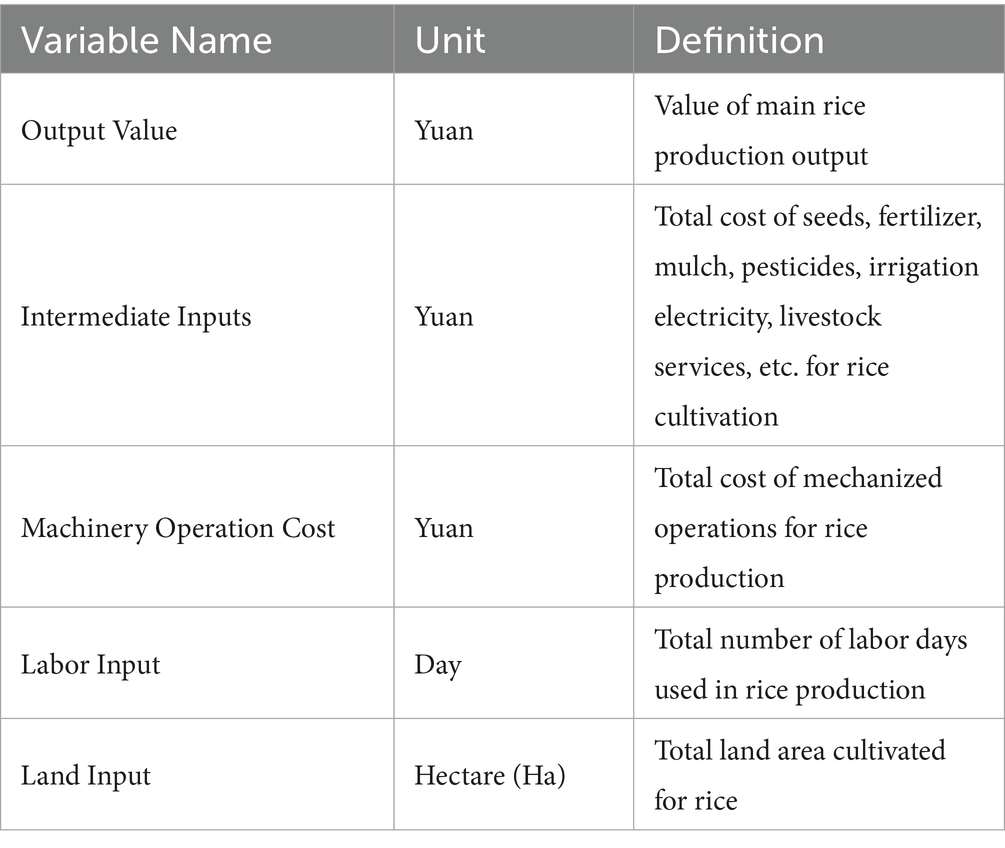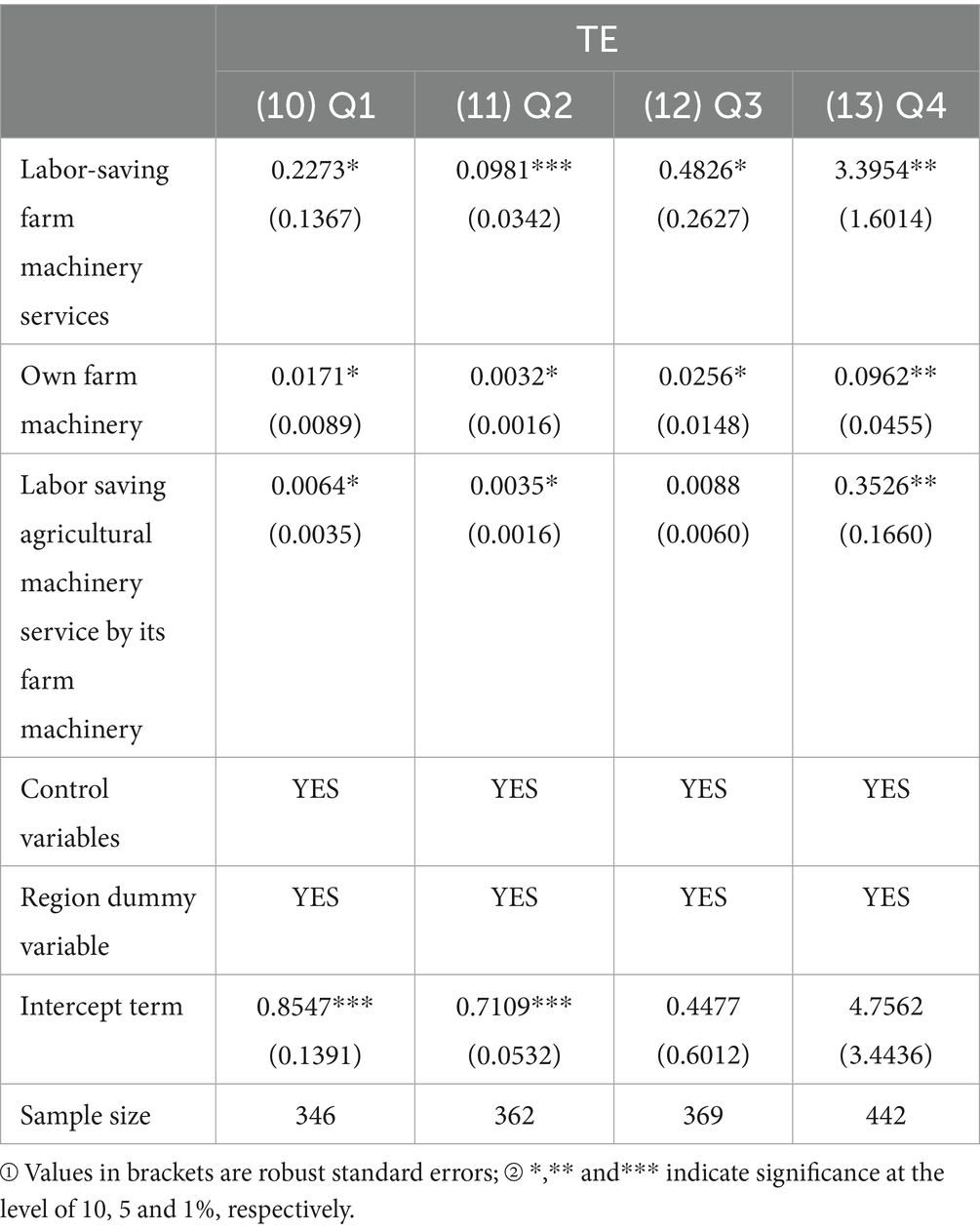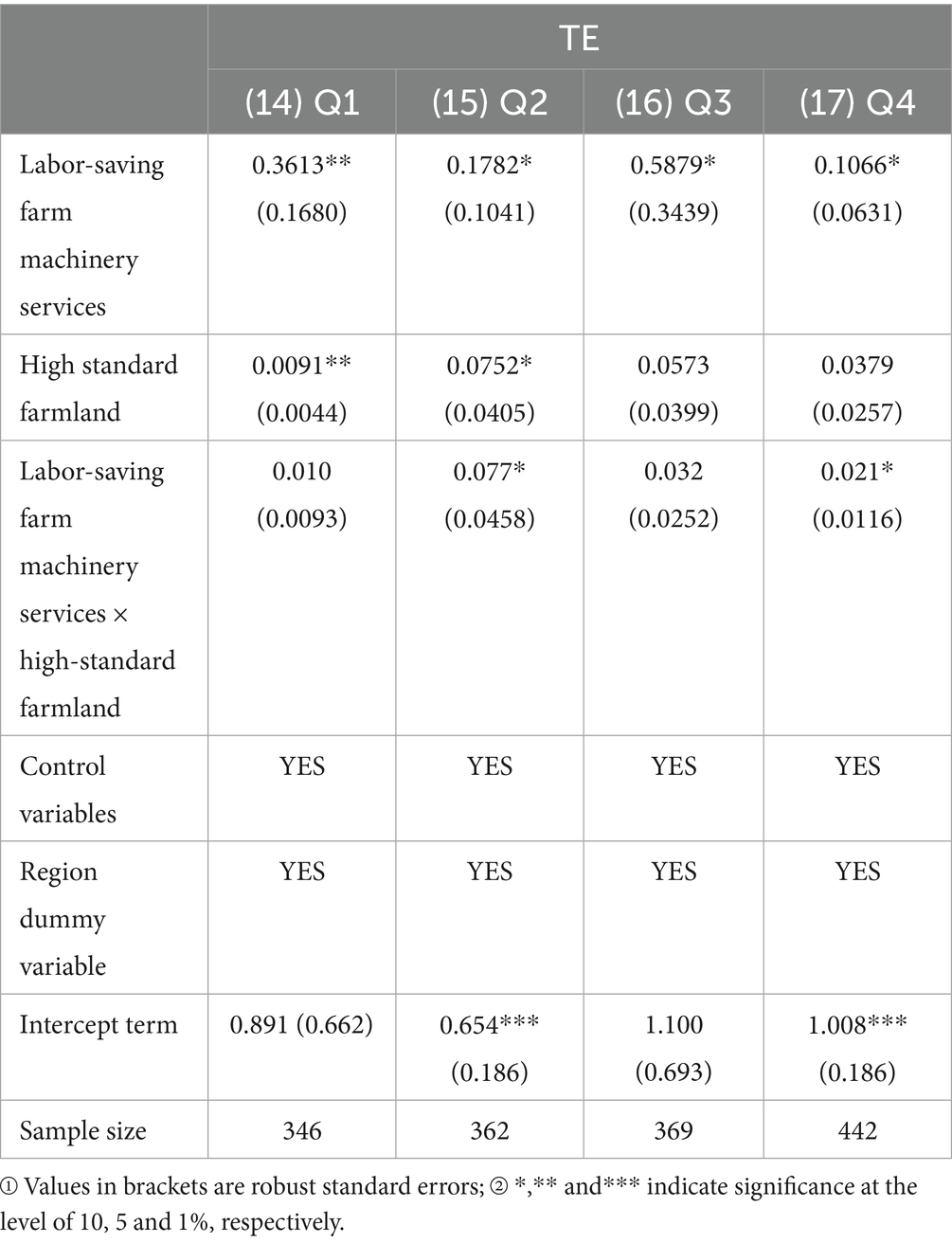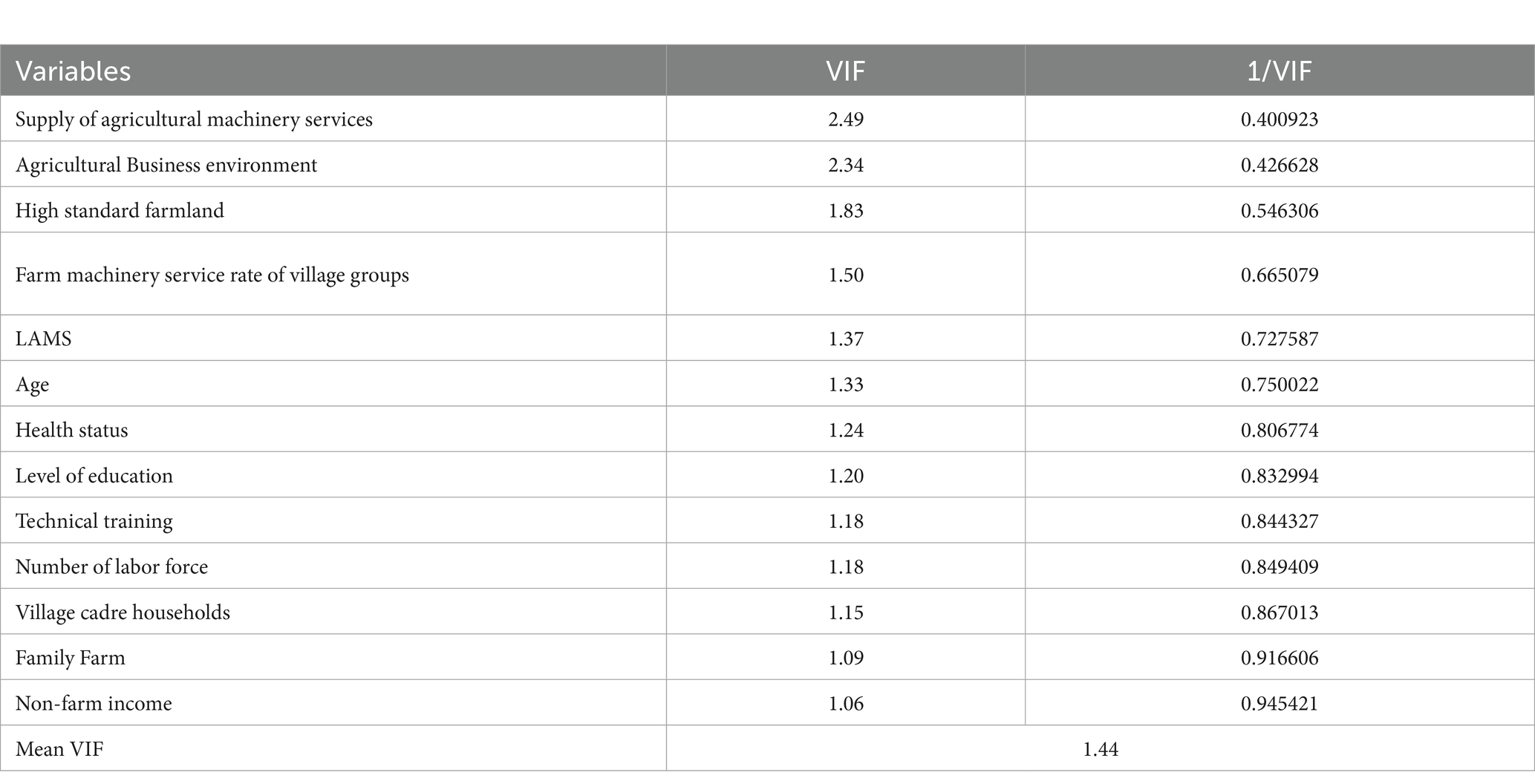- 1Institute of New Structural Economics, Peking University, Beijing, China
- 2Department of Public Finance, Chinese Academy of Fiscal Sciences, Beijing, China
- 3School of Economics, Guizhou University, Guiyang, China
Introduction: In the context of accelerating industrialization and urbanization, China’s agricultural production faces challenges such as labor shortages and fragmented land supply. Labor-saving agricultural mechanization services (LAMS) have emerged as a scalable factor innovation to address such issues. However, the efficiency implications and moderating factors of LAMS adoption remain insufficiently understood.
Methods: Using 2019 cross-sectional survey data from 1,519 medium indica rice growers in China, this study investigates the impact of LAMS adoption on technical efficiency (TE) using a stochastic frontier analysis (SFA) approach. To address endogeneity concerns, a two-stage least squares (2SLS) instrumental variable strategy is employed. Moderating effect models further identify causal effects of market- and policy-based factors.
Results: The results show that LAMS adoption significantly improves technical efficiency. Market factors—measured by self-owned machinery—exhibit a substitution effect with LAMS, while policy factors—proxied by high-standard farmland construction (HSFC)—demonstrate complementary effects. Robustness checks confirm the validity of these effects across income groups.
Discussion: The findings suggest that service-based mechanization can alleviate structural constraints such as land fragmentation and labor scarcity. LAMS offer a viable pathway to enhance smallholder productivity. These insights provide valuable policy implications for agricultural transformation in land-constrained developing economies.
1 Introduction
Global agricultural output quadrupled between 1961 and 2020, accompanied by a 53% rise in per capita output. However, the post-2010 period witnessed decelerating productivity growth, escalating food price indices, and mounting pressure on natural resource utilization, coinciding with an increase in food-insecure populations since 2015 (Fuglie et al., 2024). Enhancing agricultural production efficiency thus emerges as a critical priority for ensuring food security.
Within China’s high-quality development agenda, synchronizing smallholder development under the Household Contract Responsibility System (HCRS) remains a fundamental challenge. According to the Third National Agricultural Census (2016), smallholders account for 98.1% of agricultural entities, with 85.2% cultivating plots smaller than 0.67 hectares. It highlight the urgency of transforming production methods under resource constraints. This investigation aligns with Sustainable Development Goal Target 2.3, which emphasizes improving smallholder productivity (Ayalew et al., 2024).
The growing specialization of agricultural mechanization services (AMS) aligns with Alesina and Rosenthal's (1996) theoretical proposition that economic development entails functional disaggregation, where specialized entities assume responsibility for discrete production stages. Empirical evidence shows that mechanization service providers enhance both farm-level efficiency and sector-wide productivity through technology diffusion. China’s agricultural modernization exemplifies this trajectory, where productivity growth are driven by ongoing technological advancement and its spatial dissemination across farming operations. Huang and Yang (2017) identify machinery investment as a critical channel for adopting productivity-enhancing technologies.
Unlike traditional ownership-based mechanization models that primarily benefits large-scale farms, AMS provides smallholders access to capital-intensive technologies through market-based outsourcing (Van Loon et al., 2020; Lu et al., 2022). By decoupling machinery use from ownership, AMS reduce fixed costs and facilitate the diffusion of advanced equipment among fragmented and resource-constrained rural producers (Yang et al., 2013). AMS improve production efficiency through two primary channels: direct technical improvements through mechanized operations and indirect market effects via demand-driven service linkages. The former boosts in-field operational efficiency, while the latter reduces transaction costs through specialized service provider networks.
Labor-saving Agricultural Mechanization Services (LAMS), a subset of AMS, refer to outsourced mechanized operations—such as plowing, sowing, and harvesting—provided by third-party service organizations or machinery-owning households. These services substitute machine labor for manual labor in physically intensive production stages, enabling smallholders to benefit from mechanization without owning equipment. The widespread adoption of LAMS in China over the past two decades has been driven by rapid industrialization and urbanization, which have triggered large-scale rural labor outmigration. As younger and more educated workers leave agriculture for better-paid nonfarm employment in cities, rural households face growing labor shortages and rising opportunity costs of on-farm work. Under such demographic and structural shifts, the demand for labor-saving technologies—particularly those that can be flexibly accessed through service outsourcing—has increased significantly.
Meanwhile, government investment in agricultural infrastructure, especially high-standard farmland construction (HSFC), has further facilitated the diffusion of LAMS by improving land conditions and machinery accessibility (Zhang et al., 2017). This dual transformation—labor outflow due to industrialization and institutional support for mechanization—offers a unique context to examine how service-based mechanization interacts with household heterogeneity and policy environment to influence agricultural productivity. While the literature has documented the rapid rise of AMS (Benin, 2015; Tufa et al., 2024), few studies have rigorously analyzed the mechanisms through which LAMS influence technical efficiency (TE) at the household level, especially under the land tenure constraints embedded in the HCRS.
Existing research often treats mechanization as a homogenous category, overlooking important distinctions between capital-deepening ownership and service-oriented outsourcing (Hamilton et al., 2022; Paul and Yasar, 2009). This masks key differences in access and outcomes. For instance, Lu et al.(2022) find that LAMS adoption for plowing and transplanting significantly increases rice yields in China, whereas less observable services, such as pesticide spraying, may generate negative productivity effects due to moral hazard. These findings underscore the dual nature of LAMS—as both a technological substitute for labor and an organizational innovation with principal-agent dynamics.
Theoretically, LAMS differ from conventional mechanization by introducing new transaction costs and coordination challenges, while simultaneously enabling scale economies through demand aggregation (Pingali, 2007; Van Loon et al., 2020). Under the framework of induced institutional innovation, LAMS can be viewed as an adaptive response to mismatches in land fragmentation, labor scarcity, and capital indivisibility. Despite their growing policy relevance, most empirical studies focus on adoption determinants rather than evaluating causal impacts on production efficiency (Lu et al., 2022; Zhang et al., 2017).
This study contributes to the literature in four ways. First, it develops a moderated effects framework to examine how LAMS and institutional policy jointly affect household-level TE. Second, it applies a two-stage econometric strategy using nationally representative survey data and instrumental variables to mitigate endogeneity in LAMS adoption. Third, by disaggregating machinery ownership from service usage, the study reveals heterogeneous efficiency outcomes based on household endowments and land characteristics. Fourth, from a global perspective, it offers insights into how service-based mechanization may improve productivity in smallholder systems characterized by fragmented land tenure, labor migration, and underdeveloped markets (Benin, 2015; Tufa et al., 2024). Overall, this paper provides empirical evidence on the micro-foundations of mechanization-driven productivity in fragmented land system, with practical implications for rural modernization strategies across the Global South.
2 Theoretical framework
LAMS represent a distinct form of mechanization that diverges from traditional capital-deepening pathways. It refer to outsourced machinery services—including plowing, sowing, harvesting, irrigation, pesticide application, equipment maintenance, and leasing—provided by service organizations or machinery-owning households to agricultural producers for a fee. A central advantage of LAMS lies in their ability to separate ownership from use, thereby reducing fixed investment burdens for smallholders and enabling access to mechanized technologies through market transactions. Unlike capital-intensive mechanization models that require large operational scales, LAMS allow small and fragmented producers to benefit from mechanization.
The functional differentiation of LAMS can be understood through the lens of production stage intensity. Agricultural production can be divided into labor-intensive and technology-intensive stages. Labor-intensive tasks include plowing, sowing, and harvesting, which heavily rely on manual labor, whereas technology-intensive tasks such as fertilization, irrigation, and pesticide application demand technical precision and expertise. Based on the classification of labor-saving versus resource-saving technologies in the theory of technical change, LAMS in this study correspond to labor-saving technologies: they substitute mechanical power for labor in physically demanding production stages, particularly within the ‘plow-sow-harvest’ cycle.
This functional design of LAMS plays a critical role in improving TE. TE is defined as the ratio of observed output to the maximum attainable output given a set of inputs, reflecting the extent to which producers minimize input waste. TE is conceptually distinct from total factor productivity (TFP): the former is a micro-level indicator of efficiency under a given technology, while the latter captures macro-level gains driven by innovation, economies of scale, and resource reallocation. As such, TE provides a more appropriate measure for assessing farm-level performance under real-world constraints.
LAMS influence TE through several channels. First, they alleviate labor bottlenecks during peak seasons by mechanizing time-sensitive tasks, thereby reducing yield losses caused by delays. Second, they improve input allocation by enabling scale-consistent machinery matching, especially under fragmented landholding conditions. Third, by lowering capital entry thresholds, LAMS allow farmers to reallocate scarce financial resources toward complementary inputs such as improved seeds, fertilizers, or technical services. These mechanisms collectively enhance a producer’s ability to reach the production frontier—that is, to achieve output levels closer to the technically feasible maximum.
In sum, LAMS are not merely substitutes for labor, but also represent an institutional innovation that helps smallholders overcome structural inefficiencies in land, labor, and capital allocation. Their role in enhancing TE reflects the convergence of market-based service delivery with the diffusion of productivity-enhancing technologies in the modernization of smallholder agriculture. This paper empirically analyzes the indirect effects of LAMS on agricultural production efficiency from two perspectives: market factors and policy factors.
2.1 Market factor
We begin the analysis from the demand-side perspective of farmers. According to the theory of induced technical change, increases in the relative prices of labor and machinery stimulate farmers’ demand for agricultural mechanization. Farmers typically adopt mechanized production either by purchasing agricultural machinery themselves or by procuring machinery services. From a cost-minimization and profit-maximization perspective, this decision reflects rational behavior, as farmers choose the production mode that best aligns with their resource endowments and the constraints of their operating environment.
Compared with manual labor, mechanized production can alleviate the burden of physically demanding and time-consuming tasks. However, adopting mechanized production entails certain costs, usually paid as a one-time fee to service providers or as capital investment in machinery. In practice, mechanized production requires both adequate financial capacity and alignment between machinery capacity and farm scale. On the one hand, farmers must be able to afford either machinery ownership or service fees. On the other hand, machinery use must be efficient—ideally, production scale should closely match machinery capacity. In cases of overcapacity, machinery-owning farmers can provide services to others, reducing idle costs and generating additional income.
When deciding on a production model, farmers must consider multiple factors. First, mechanized agriculture can improve household income through both output and substitution effects: increased yields compared to manual labor and the release of surplus labor for off-farm employment. Second, farmers must assess whether they can afford machinery and whether it can be fully utilized to enhance household returns. Under rational expectations, farmers will opt for the model that maximizes total income.
However, high purchase prices and significant transaction costs often prevent smallholders from affording agricultural machinery. Since the landholdings are highly fragmented, if all farmers were to purchase machinery individually, this would lead to significant overcapacity and idle assets, ultimately reducing resource allocation efficiency. Therefore, limited purchasing capacity and small-scale operations mean that not all farmers can achieve mechanization through ownership. For those lacking capital or scale, purchasing machinery services offers a viable alternative to realize mechanized production.
Based on the above analysis, this paper proposes the following hypothesis:
H1: When the farmers with less machine choose agricultural machinery service, their production efficiency will be improved more significantly.
2.2 Policy factor
As a core component of China’s agricultural development strategy, the HSFC Project aims to stabilize the quantity of arable land, improve land quality, and enhance the agricultural ecological environment. According to the General Rules for HSFC (GB/T 30600-2014), high-standard farmland is defined as permanently protected arable land designated as basic farmland, characterized by leveled terrain, spatial contiguity, comprehensive infrastructure, reliable agricultural power supply, fertile soil, resilient ecosystems, and strong disaster resistance. Such land is expected to support modern agricultural production systems capable of sustaining stable, high yields under both drought and flood conditions.
Since its nationwide rollout in 2011, land engineering has served as the cornerstone of HSFC policy. This initiative has employed field consolidation strategies—such as small-to-large field integration and fragmented-to-contiguous reconfiguration—to achieve land leveling and coordinated plot management. These measures have demonstrably reduced land fragmentation and expanded both individual plot size and the overall operational scale. In parallel, land exchange programs maintain total cultivated area while enlarging contiguous field dimensions at the household level.
The policy’s land adaptation for mechanization approach promotes plot-level scale economies, thereby increasing the feasibility and efficiency of agricultural mechanization services. Plot consolidation enhances mechanization through two primary mechanisms. First, contiguous field layouts improve operational conditions for labor-intensive tasks such as tillage, sowing, and harvesting. Second, reduced spatial discontinuities lower input transport costs and decrease the transaction costs associated with procuring machinery services, thus enabling providers to deliver services more efficiently.
Importantly, both self-owned machinery and outsourced mechanization services require terrain compatibility—specifically, leveled land, accessible field roads, and concentrated operating areas. Through infrastructure investments (e.g., field road construction) and land consolidation, the high-standard farmland policy systematically improves the physical environment for agro-mechanization. These terrain adaptation efforts have contributed to the development of local agricultural machinery service markets, especially for labor-intensive production stages, and have ultimately facilitated measurable gains in agricultural productivity. Therefore, this paper puts forward the following hypothesis:
H2: HSFC Project have a moderating effect on the impact of LAMS on agricultural production efficiency.
3 Date and models
3.1 Data sources
The empirical analysis utilizes data from China’s National Rural Fixed Observation Point Survey, a nationally representative longitudinal survey system established in 1984 by the Ministry of Agriculture and Rural Affairs. As the most authoritative socioeconomic monitoring system covering rural China, it encompasses 368 counties and 375 sample villages across 31 provincial-level administrative units, involving 23,000 registered farming households and over 1,600 new agricultural business entities through standardized bookkeeping procedures.
This study focuses on factor allocation and production efficiency among farmers, using rice—China’s primary staple grain—as the focal crop. Given its moderate photosensitivity, stable growth duration, and broad regional adaptability, medium indica rice is selected as a representative type. All household production variables analyzed in this study are based on medium indica rice cultivation.
To ensure empirical rigor and regional relevance, the analysis draws on cross-sectional data from 2019, selecting 10 major indica rice-producing provinces (autonomous regions/municipalities) based on agricultural zoning maps and data accessibility criteria. After implementing rigorous data cleaning protocols—including removal of incomplete responses, outlier detection using interquartile range methods, and verification of internal consistency—the final analytical sample comprises 1,519 qualified observations. This geographical concentration ensures analytical validity given the study’s emphasis on mechanization patterns in staple grain production systems.
3.2 Variable selection
3.2.1 Explained variable
The explained variable is agricultural production TE, which is calculated by the Stochastic Frontier Analysis (SFA) model proposed by Aigner et al. (1977) and Meeusen and van den Broeck (1977). Whose general equation is specified in Equation (1):
Where, is the actual amount of output, is the value of potential output, denotes the input factor vector, is the random error term, denotes the technical inefficiency term. Assuming is the potential output, then the TE should be calculated as Equations (2–4):
In the SFA model, output is measured by the value of rice production. Input variables include (Table 1): (1) land area under rice cultivation, (2) labor input measured in person-days, (3) intermediate inputs covering seeds, fertilizers, pesticides, irrigation electricity, and livestock services, and (4) mechanized service expenditures. These variables capture the main factors of production and align with standard input–output modeling in agricultural efficiency analysis.
3.2.2 Core explanatory variables
This study focuses on identifying the mechanisms through which LAMS influence agricultural production efficiency. The core explanatory variable—LAMS adoption—is operationalized as a binary indicator that equals 1 if a medium-indica rice grower procured mechanized services during labor-intensive production stages, and 0 otherwise. This specification enables empirical estimation of the impact of LAMS adoption on household-level TE.
3.2.3 Moderating variables
Moderating variables are constructed in line with the proposed analytical framework. Farmer-owned agricultural machinery quantity serves as the proxy for market-related factors, while participation in HSFC programs captures policy-related influences. This dual approach reflects institutional economics theory and market access dynamics, allowing for the analysis of interaction effects between LAMS and external contextual factors.
3.2.4 Instrumental variable
To address potential endogeneity concerns typical of observational data, an instrumental variable strategy is employed. The village-level penetration rate of agricultural machinery services is used as an instrument. This variable exploits spatial variation in service diffusion while satisfying the exclusion restriction through the assumption that regional adoption patterns affect individual LAMS uptake but not household-level efficiency directly.
3.2.5 Control variable
The model includes a comprehensive set of household-level and village-level control variables. Household characteristics encompass demographic and socioeconomic indicators, including the age, education, and health status of the household head; participation in agricultural technical training; household labor force size; cadre status (political affiliation); share of non-agricultural income; and family farm registration. Village-level controls include the dominant type of agricultural operation and the availability of agricultural machinery services within the village. To control for unobserved regional heterogeneity, provincial fixed effects are included in the stochastic production frontier model. Detailed definitions and descriptive statistics of all variables are reported in Table 2.
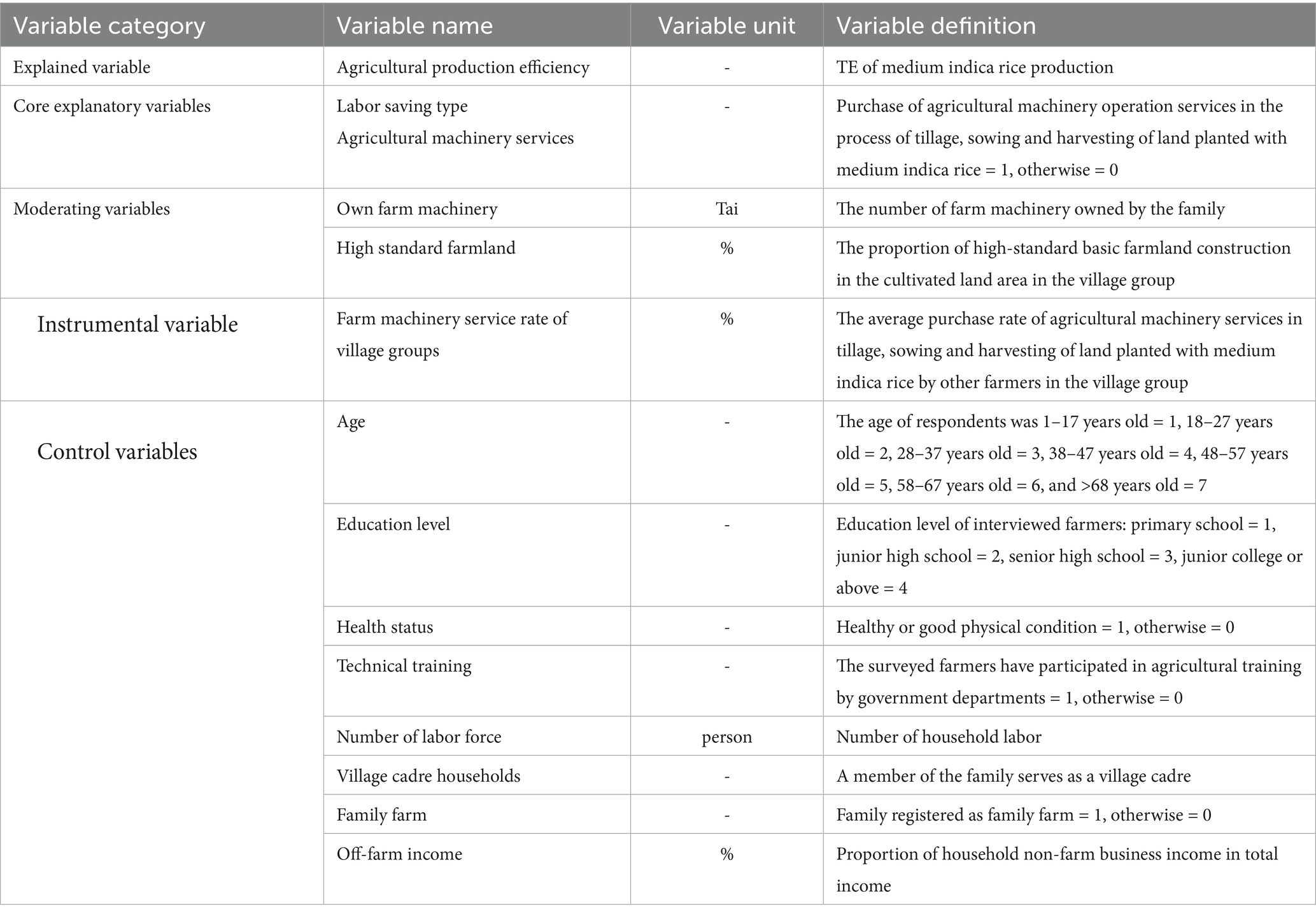
Table 2. Variable description of indirect effect model of labor-intensive agricultural machinery service on agricultural production efficiency.
3.3 Model setting
3.3.1 Benchmark regression
First, the OLS model was used for the analysis. The benchmark model is established as Equation (5) shows:
Where, represents the production efficiency of medium-indica rice by farmers, represents the variable of purchasing agricultural machinery services, and represents the control variable. represents the constant term of the model, represents the coefficient to be estimated for the agricultural machinery service variable, represents the coefficient to be estimated for each control variable, and represents the random error term of the model.
3.3.2 The treatment of endogeneity problem
To address potential endogeneity concerns, this study employs an instrumental variable (IV) strategy. A valid instrument must satisfy two key conditions: relevance—i.e., a strong correlation with the endogenous regressor—and exogeneity, meaning independence from the error term in the structural equation. The latter condition, known as the exclusion restriction, requires that the instrument affects the dependent variable only through its relationship with the endogenous explanatory variable, with no alternative causal pathways.
The chosen instrument is the village-level adoption rate of LAMS, operationalized as the proportion of neighboring farmers within the administrative village who procure mechanization services. This measure captures spatial peer effects in technology adoption: farmers often observe and learn from their neighbors, leading to correlated adoption behaviors. The instrument satisfies the relevance condition because neighboring adoption significantly influences individual farmers’ decisions through information diffusion and social learning. It satisfies the exogeneity condition because neighbors’ adoption decisions are unlikely to correlate with unobserved determinants of the focal household’s production efficiency, except through the endogenous adoption of LAMS.
This IV strategy is theoretically grounded on three considerations. First, village-level adoption rates reflect the development of localized service markets. Second, spatial autocorrelation in adoption behavior arises from shared institutional, infrastructural, and informational environments. Third, using the administrative village as the unit of analysis reduces the likelihood of cross-regional spillover effects, thereby enhancing the plausibility of the exclusion restriction. This strategy enables consistent estimation of the causal impact of LAMS adoption under the stated identification assumptions.
3.3.3 Moderating effect model of market factors
The theoretical framework posits that market forces may incentivize farmers’ adoption of agricultural machinery services (LAMS), potentially moderating the relationship between service procurement and agricultural productivity. To empirically examine this hypothesized market-mediated effect, the analysis incorporates a moderating variable quantifying privately-owned agricultural machinery assets. Specifically, an interaction term between LAMS adoption and machinery ownership is introduced into the baseline regression specification, formalized as Equation (6):
Where denotes the household’s self-owned agricultural machinery stock. All other variables maintain their baseline model definitions and operationalizations. This multiplicative specification enables explicit testing of how market-driven machinery availability moderates LAMS’ productivity effects.
3.3.4 Moderating effect model of policy factors
The theoretical framework further suggests that policy interventions may incentivize farmers’ adoption of agricultural machinery services (LAMS), potentially moderating the service-productivity relationship. To empirically assess this policy-mediated mechanism, HSFC participation is incorporated as a moderating variable through interaction effects. The extended regression specification formalizes this analytical approach as Equations (7, 8) shows:
Where indicates household participation in HSFC programs. All other variables retain their baseline model definitions and measurement protocols. This interaction term specification enables precise estimation of how policy-driven infrastructure improvements condition LAMS’ productivity effects.
4 Results
4.1 Benchmark regression
4.1.1 Model test
The empirical analysis employs ordinary least squares (OLS) and two-stage least squares (2SLS) estimation methods with regional fixed effects. Diagnostic tests confirmed heteroscedasticity (Breusch-Pagan test, p < 0.01), addressed using robust standard errors. Variance inflation factor (VIF) analysis ruled out multicollinearity (maximum VIF = 2.49). A summary of the main regression results is available in the Table A1.
The first-stage regression results confirm the relevance of the instrument, and its statistical insignificance in the second-stage regression with respect to TE supports the exclusion restriction. To further test for endogeneity, a Durbin–Wu–Hausman test was conducted by including the residuals from the first-stage regression in the structural model. The significance of the residual term (p < 0.05) leads to the rejection of the null hypothesis of exogeneity, thus validating the use of the IV approach (Table 3).
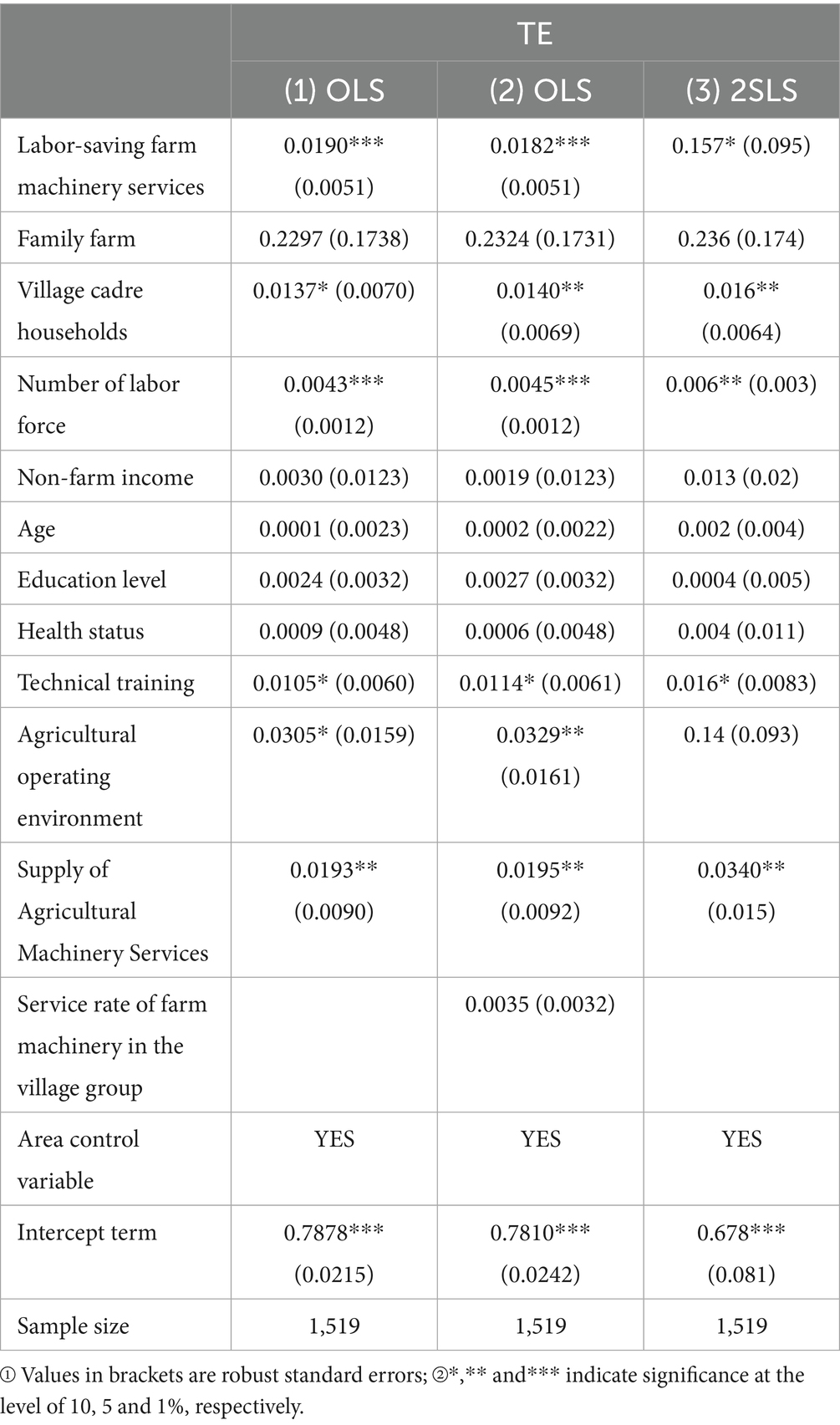
Table 3. Effect of labor-intensive agricultural machinery services on agricultural production efficiency (2SLS).
Specification (3) presents the 2SLS estimation results using village-level agricultural machinery service adoption as an instrument for LAMS. Diagnostic tests confirm the validity of identification assumptions, including instrument relevance, robustness against weak instruments, and exogeneity. The findings reveal a statistically significant positive effect of LAMS adoption on TE, suggesting that mechanization in labor-intensive indica rice cultivation improves productivity through more efficient factor allocation. These efficiency gains are particularly notable in the context of rising rural wages and the increasing opportunity cost of agricultural labor due to non-farm employment.
Control variable estimates yield several key insights. First, household labor availability, participation in technical training, and access to local machinery services are all positively associated with TE. Second, village cadre status shows a negative correlation with efficiency. This counterintuitive finding aligns with dual mechanisms of social capital identified by Su and He (2013). On one hand, political connections may provide access to off-farm income opportunities, thereby reducing household agricultural labor input. On the other hand, social capital’s productivity-enhancing effects are scale-dependent — beneficial for medium to large-scale farms, but less impactful for smallholders cultivating less than 3.33 hectares (Li et al., 2016). Given that this study focuses on small-scale farms (below 3.33 ha), the negative coefficient likely reflects reduced agricultural input intensity among politically connected households.
Comparable findings have been observed in other contexts where service outsourcing mitigates inefficiencies linked to suboptimal scale. For example, Picazo-Tadeo and Reig-Martínez (2006) find that outsourcing mechanical operations in Spanish citrus production enhances TE by lowering fixed capital costs and reducing input misallocation. Similarly, the results here suggest that LAMS substitute capital for labor and expand smallholder access to specialized services, thereby promoting efficiency in fragmented farming systems.
4.1.2 Effect of LAMS on agricultural production efficiency under the effect of market factors
Table 4 presents the moderating effects of market factors on the relationship between LAMS and TE. Specification (4) reports baseline ordinary least squares (OLS) estimates, while Specification (5) incorporates the instrumental variable—village-level agricultural machinery service adoption rates—while maintaining instrument exogeneity, as confirmed by the statistical insignificance of the instrument in the second-stage regression.
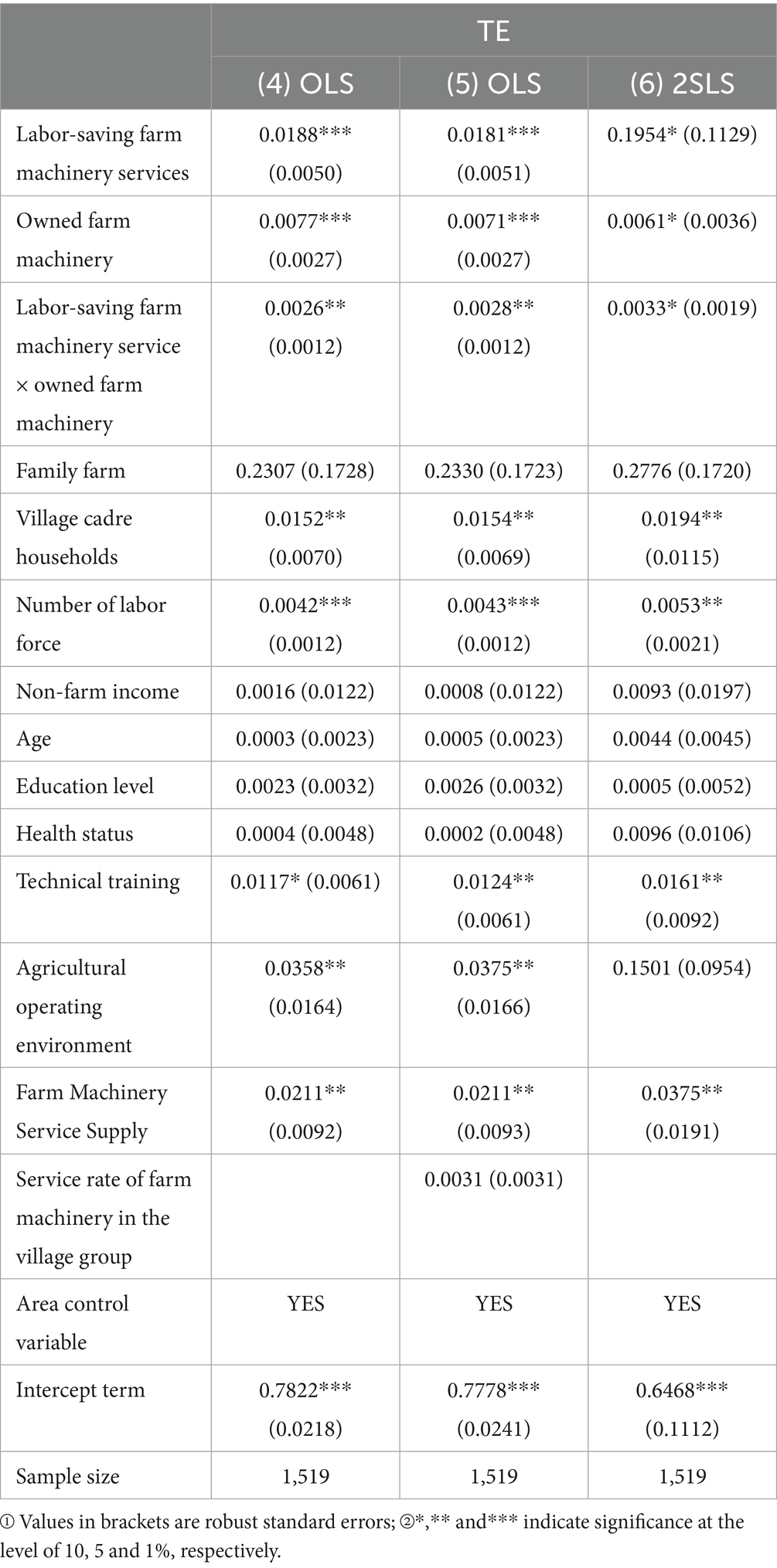
Table 4. The moderating effect of owned farm machinery on labor-intensive farm machinery service on agricultural production efficiency.
Specification (6) reports the two-stage least squares (2SLS) estimates, yielding two key findings. First, self-owned agricultural machinery exhibits a statistically significant positive effect on TE, suggesting that capital-deepening through machinery ownership contributes to productivity gains. Second, the negative coefficient on the interaction term between LAMS adoption and machinery ownership confirms a substitution effect—households tend to substitute between owning machinery and purchasing mechanization services, rather than combining them complementarily.
These results are consistent with prior findings that highlight the positive effects of household labor availability, participation in technical training, and access to local service markets on productivity. Overall, the evidence supports research hypothesis H1, demonstrating that market-driven factors moderate the effectiveness of LAMS through substitution mechanisms between ownership and outsourcing.
4.1.3 Effect of LAMS on agricultural production efficiency under agricultural development policy
Table 5 presents the moderating effects of policy-related factors on TE. Specification (7) reports baseline ordinary least squares (OLS) estimates, while Specification (8) incorporates the instrumental variable—village-level agricultural machinery service adoption rates—with the instrument’s statistical insignificance in the second stage satisfying the exclusion restriction.
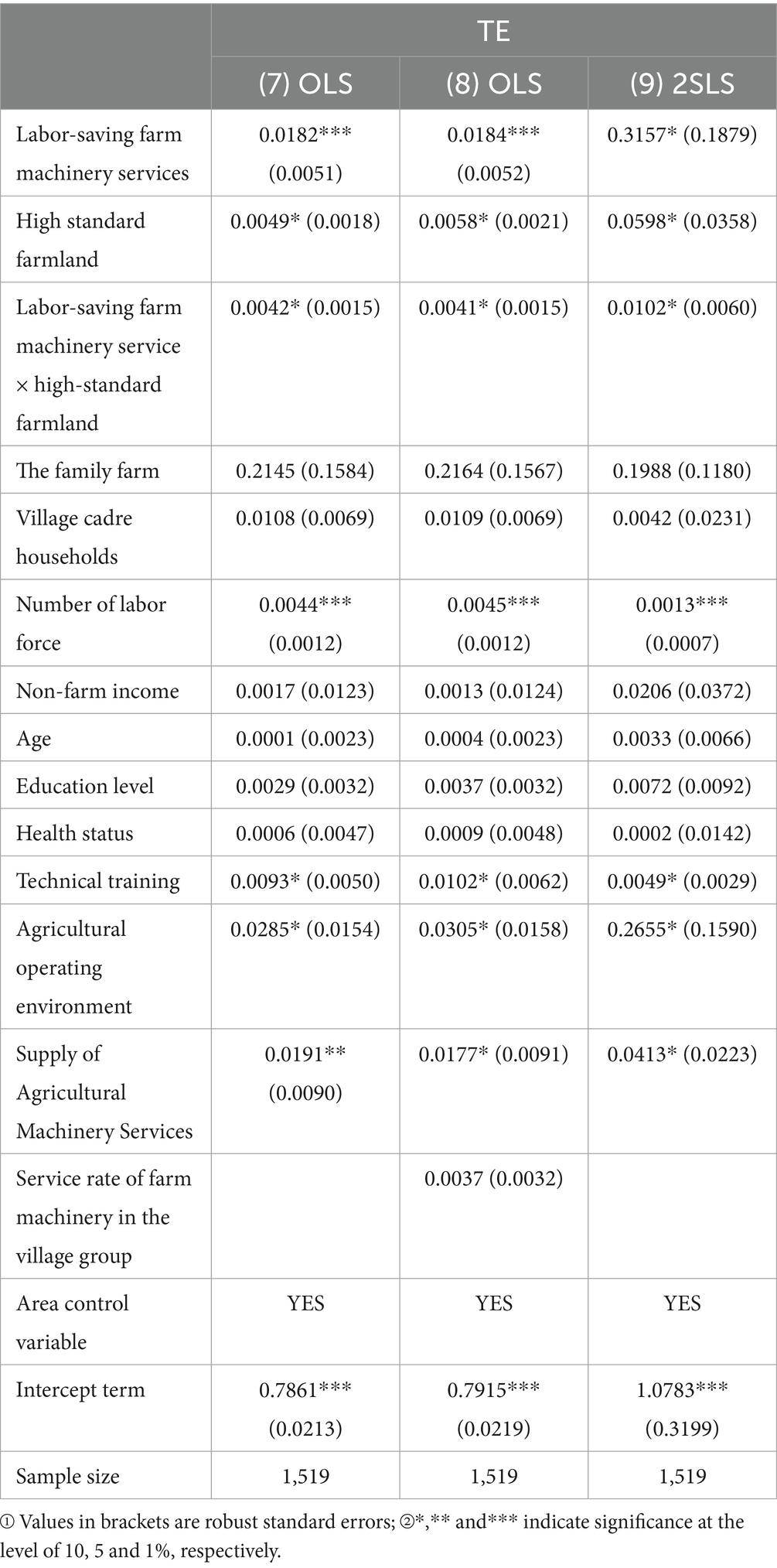
Table 5. The moderating effect of high standard farmland on labor-intensive agricultural machinery service on agricultural production efficiency.
Specification (9) displays the two-stage least squares (2SLS) results and reveals two principal findings. First, HSFC has a statistically significant positive effect on TE, confirming that land consolidation policies improve input allocation and production conditions. Second, the positive and significant interaction between LAMS adoption and farmland modernization indicates a complementary effect—policy infrastructure enhances the effectiveness of mechanization services.
These findings are consistent with prior evidence that household labor endowment, participation in technical training, and access to local services positively influence productivity. In addition, the operational environment variable—measured by enterprise participation in agricultural collectives—shows a positive and significant association with efficiency.
Overall, the results support research hypothesis H2, demonstrating that policy interventions such as HSFC enhance the productivity impact of LAMS. The interaction between LAMS and HSFC illustrates how infrastructural policies can mitigate constraints arising from land fragmentation and capital indivisibility. This finding aligns with recent evidence from Chari et al.(2021), which shows that land tenure reform and infrastructure investment significantly reduce land misallocation and improve agricultural productivity in China.
4.2 Robustness test
To verify the consistency of the main findings and assess the indirect effects of LAMS on TE, robustness tests are conducted through heterogeneous analysis based on household income levels. The sample is stratified into income terciles to examine whether the impact of LAMS varies across different economic contexts.
4.2.1 The effect of LAMS on agricultural production efficiency under the effect of market factors
Table 6 presents instrumental variable estimates evaluating the effects of both self-owned machinery and LAMS adoption across different income groups. Three key findings emerge: (1) Both LAMS procurement and machinery ownership contribute positively to TE across all income strata, though the magnitude and significance vary; (2) Among low-income households, the interaction between LAMS and machinery ownership shows a complementary relationship—suggesting that these producers rely on both ownership and service procurement to overcome capital and labor constraints; (3) In contrast, middle- and high-income groups exhibit substitution effects, with high-income households’ interaction terms remaining statistically insignificant. These findings suggest divergent mechanization strategies, where lower-income farmers utilize mixed approaches to mechanization, while higher-income households increasingly rely on service outsourcing.
4.2.2 Effect of LAMS on agricultural production efficiency under the influence of policy factors
Table 7 explores the interaction between LAMS and HSFC across income groups. The analysis yields three main results: (1) LAMS adoption significantly enhances TE in all income terciles; (2) HSFC exerts stronger positive effects among low- and middle-income households, likely due to their greater dependence on land as a primary production factor; (3) The interaction term between LAMS and HSFC is consistently positive and significant across income strata, confirming the presence of infrastructure-service complementarity. The magnitude of this moderating effect varies systematically, with the strongest synergy observed among middle- and low-income households.
These robustness checks reinforce the study’s main conclusions and suggest that both market and policy environments condition the effectiveness of LAMS in improving production efficiency—especially among smallholders facing capital and land constraints.
5 Limitations
This study has several limitations. First, while the HSFC variable is measured at the village-group level and TE is assessed at the household level—raising the potential for ecological fallacy—we interpret HSFC as a contextual proxy representing shared infrastructure conditions rather than a direct household-level treatment. Second, some unobserved household characteristics may remain uncontrolled due to data limitations, introducing possible residual selection bias. These limitations do not undermine the study’s core findings but highlight opportunities for future research using panel data and multi-level modeling.
6 Conclusion
This study systematically investigates mechanisms for enhancing smallholder agricultural productivity. Specifically, it examines (1) modern production factor integration pathways for smallholders, (2) the productivity effects of LAMS through technological diffusion and functional specialization, and (3) contextual factors influencing the effectiveness of LAMS adoption. These inquiries aim to understand how resource-constrained producers can utilize institutional innovations to achieve productivity gains.
The empirical analysis develops a moderated effects framework to evaluate the impact of LAMS on TE, incorporating both market and policy factors. Results show that LAMS adoption significantly improves TE. Market factors—such as self-owned machinery—exhibit a substitution effect, reducing LAMS’ marginal returns, while policy infrastructure—measured by HSFC—positively moderates LAMS effects. These findings validate hypotheses H1 and H2. Income-stratified robustness checks further reveal heterogeneity in LAMS effectiveness and infrastructure-service complementarity, underscoring differential adoption pathways across income groups.
This study extends the existing literature on agricultural mechanization. While previous research emphasizes yield enhancement and adoption determinants, our findings identify TE improvement as a key outcome and highlight LAMS’ capacity to mitigate inefficiencies stemming from land fragmentation and labor scarcity. Additionally, we demonstrate the complementary role of infrastructure by showing how HSFC amplifies the effectiveness of LAMS.
From an international perspective, the results offer insights into how service-based mechanization—when supported by land-use reforms—can enhance productivity in smallholder systems. Theoretically, this study contributes to understanding service-based mechanization as a form of induced institutional innovation suited to land-constrained, labor-scarce economies. Practically, the findings provide policy guidance for developing countries seeking to scale mechanization through decentralized service systems aligned with land-use infrastructure improvements.
Importantly, the study underscores the role of institutional context. Unlike much of the literature that focuses solely on LAMS adoption behavior, this analysis incorporates the moderating effect of HSFC, revealing how policy-led land consolidation enhances the impact of service-based mechanization. These results deepen our understanding of the interactions between labor-saving services, land-use policy, and household heterogeneity, and support the case for integrated agricultural modernization strategies in China and other developing countries.
Beyond this, several extensions merit exploration for future research. An illustrative case is employing panel datasets or longitudinal tracking surveys to assess the dynamic impacts of LAMS adoption over time, capturing persistence, spillover, and potential learning effects. In addition, more detailed investigation into the organizational structure and governance of service providers—such as cooperatives, enterprises, or informal networks—could offer insights into how service delivery mechanisms mediate mechanization outcomes.
Data availability statement
The data analyzed in this study is subject to the following licenses/restrictions: The dataset used in this paper comes from the micro-study data of farmers in the national fixed observation point of the Ministry of Agriculture and Rural Affairs of China. The Ministry of Agriculture and Rural Affairs has strict restrictions on the use of this data. It can only be used in a specific computer room at the agreed time. The data cannot be disclosed. Data users can only copy the analysis results for academic research. Requests to access these datasets should be directed to http://www.rcre.agri.cn/jigou/csjs/gdgcdglc/. This is the official introduction of the administration of national fixed observation system.
Author contributions
DY: Conceptualization, Formal analysis, Investigation, Methodology, Project administration, Supervision, Writing – original draft, Writing – review & editing. QY: Methodology, Software, Visualization, Writing – review & editing. MH: Funding acquisition, Resources, Supervision, Writing – review & editing.
Funding
The author(s) declare that financial support was received for the research and/or publication of this article. This research was funded by [National Natural Science Foundation] grant number [72163003].
Conflict of interest
The authors declare that the research was conducted in the absence of any commercial or financial relationships that could be construed as a potential conflict of interest.
Generative AI statement
The author(s) declare that no Gen AI was used in the creation of this manuscript.
Publisher’s note
All claims expressed in this article are solely those of the authors and do not necessarily represent those of their affiliated organizations, or those of the publisher, the editors and the reviewers. Any product that may be evaluated in this article, or claim that may be made by its manufacturer, is not guaranteed or endorsed by the publisher.
References
Aigner, D., Lovell, C. A. K., and Schmidt, P. (1977). Formulation and estimation of stochastic frontier production function models. J. Econ. 6, 21–37. doi: 10.1016/0304-4076(77)90052-5
Alesina, A., and Rosenthal, H. (1996). A theory of divided government. Econometrica 64, 1311–1341. doi: 10.2307/2171833
Ayalew, H., Chamberlin, J., Newman, C., Abay, K. A., Kosmowski, F., and Sida, T. (2024). Revisiting the size–productivity relationship with imperfect measures of production and plot size. Am. J. Agric. Econ. 106, 595–619. doi: 10.1111/ajae.12417
Benin, S. (2015). Impact of Ghana’s agricultural mechanization services center program. Agric. Econ. 46, 103–117. doi: 10.1111/agec.12201
Chari, A., Liu, E. M., Wang, S.-Y., and Wang, Y. (2021). Property rights, land misallocation, and agricultural efficiency in China. Rev. Econ. Stud. 88, 1831–1862. doi: 10.1093/restud/rdaa072
Fuglie, K. O., Morgan, S., and Jelliffe, J.United States. Department of Agriculture. Economic Research Service (2024). World agricultural production, resource use, and productivity, 1961–2020. Washington, D.C: Economic Research Service.
Hamilton, S. F., Richards, T. J., Shafran, A. P., and Vasilaky, K. N. (2022). Farm labor productivity and the impact of mechanization. Am. J. Agric. Econ. 104, 1435–1459. doi: 10.1111/ajae.12273
Huang, J., and Yang, G. (2017). Understanding recent challenges and new food policy in China. Glob. Food Secur. 12, 119–126. doi: 10.1016/j.gfs.2016.10.002
Lu, Q., Du, X., and Qiu, H. (2022). Adoption patterns and productivity impacts of agricultural mechanization services. Agric. Econ. 53, 826–845. doi: 10.1111/agec.12737
Meeusen, W., and van Den Broeck, J. (1977). Efficiency estimation from cobb-Douglas production functions with composed error. Int. Econ. Rev. 18, 435–444. doi: 10.2307/2525757
Paul, C. J., and Yasar, M. M. (2009). Outsourcing, productivity, and input composition at the plant level. Canad. J. Econ. 42, 422–439. doi: 10.1111/j.1540-5982.2009.01514.x
Picazo-Tadeo, A. J., and Reig-Martínez, E. (2006). Outsourcing and efficiency: the case of Spanish citrus farming. Agric. Econ. 35, 213–222. doi: 10.1111/j.1574-0862.2006.00154.x
Pingali, P. (2007). “Chapter 54 agricultural mechanization: adoption patterns and economic impact,” in Handbook of agricultural economics. eds. R. Evenson and P. Pingali, Agricultural Development: Farmers, Farm Production and Farm Markets (Amsterdam: Elsevier B.B.). 3, 2779–2805.
Tufa, A., Alene, A., Ngoma, H., Marenya, P., Manda, J., Matin, M. A., et al. (2024). Willingness to pay for agricultural mechanization services by smallholder farmers in Malawi. Agribusiness 40, 248–276. doi: 10.1002/agr.21841
Van Loon, J., Woltering, L., Krupnik, T. J., Baudron, F., Boa, M., and Govaerts, B. (2020). Scaling agricultural mechanization services in smallholder farming systems: case studies from sub-Saharan Africa, South Asia, and Latin America. Agric. Syst. 180:102792. doi: 10.1016/j.agsy.2020.102792
Yang, J., Huang, Z., Zhang, X., and Reardon, T. (2013). The rapid rise of cross-regional agricultural mechanization services in China. Am. J. Agric. Econ. 95, 1245–1251. doi: 10.1093/ajae/aat027
Zhang, X., Yang, J., and Thomas, R. (2017). Mechanization outsourcing clusters and division of labor in Chinese agriculture. China Econ. Rev. 43, 184–195. doi: 10.1016/j.chieco.2017.01.012
Li, B., Zhang, S., and Jiang, J. (2016). The impact of human capital and social capital on the production efficiency of large grain farmers: a perspective based on different levels of farm scale. Issues Agric. Econ. 37:110, 22–31. doi: 10.13246/j.cnki.iae.2016.05.004
Su, X., and He, G. (2013). An analysis of the impact of farmers' social capital on agricultural production efficiency: evidence from survey data in Gaoqing County, Shandong Province. J Agrotech Econ 10, 64–72. doi: 10.13246/j.cnki.jae.2013.10.007
Appendix
Keywords: labor-saving agricultural mechanization services, technical efficiency, stochastic frontier analysis, rural households, household contract responsibility system
Citation: Yangchen DC, Yang Q and Hong M (2025) Labor-saving agricultural mechanization services and the technical efficiency in agricultural production: evidence from Chinese rural households. Front. Sustain. Food Syst. 9:1600375. doi: 10.3389/fsufs.2025.1600375
Edited by:
Fuyou Guo, Qufu Normal University, ChinaReviewed by:
Yuhan Zhang, Jiangxi Agricultural University, ChinaNing Yin, Hunan Agricultural University, China
Copyright © 2025 Yangchen, Yang and Hong. This is an open-access article distributed under the terms of the Creative Commons Attribution License (CC BY). The use, distribution or reproduction in other forums is permitted, provided the original author(s) and the copyright owner(s) are credited and that the original publication in this journal is cited, in accordance with accepted academic practice. No use, distribution or reproduction is permitted which does not comply with these terms.
*Correspondence: Danny Cyra Yangchen, eWNkbjQ1MmFiY3dpbkAxNjMuY29t
 Danny Cyra Yangchen
Danny Cyra Yangchen Qisong Yang
Qisong Yang Mingyong Hong3
Mingyong Hong3